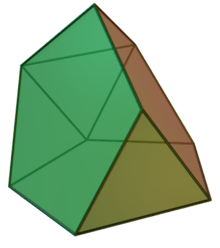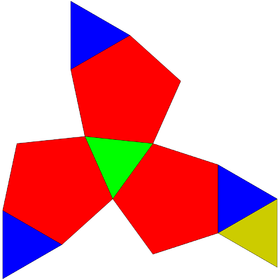| Tridiminished icosahedron | |
|---|---|
 | |
| Type | Johnson J62 – J63 – J64 |
| Faces | 5 triangles 3 pentagons |
| Edges | 15 |
| Vertices | 9 |
| Vertex configuration | |
| Symmetry group | |
| Properties | convex, non-composite |
| Net | |
 | |
In geometry, the tridiminished icosahedron is a Johnson solid that is constructed by removing three pentagonal pyramids from a regular icosahedron.
Construction
The tridiminished icosahedron can be constructed by removing three regular pentagonal pyramid from a regular icosahedron. The aftereffect of such construction leaves five equilateral triangles and three regular pentagons. Since all of its faces are regular polygons and the resulting polyhedron remains convex, the tridiminished icosahedron is a Johnson solid, and it is enumerated as the sixty-third Johnson solid . This construction is similar to other Johnson solids as in gyroelongated pentagonal pyramid and metabidiminished icosahedron.
The tridiminished icosahedron is non-composite polyhedron, meaning it is convex polyhedron that cannot be separated by a plane into two or more regular polyhedrons.
Properties
The surface area of a tridiminished icosahedron is the sum of all polygonal faces' area: five equilateral triangles and three regular pentagons. Its volume can be ascertained by subtracting the volume of a regular icosahedron with the volume of three pentagonal pyramids. Given that is the edge length of a tridiminished icosahedron, they are:
See also
- Snub 24-cell, a 4-polytope whose vertex figure is a tridiminished icosahedron
References
- ^ Gailiunas, Paul (2001), "A Polyhedral Byway" (PDF), in Sarhangi, Reza; Jablan, Slavik (eds.), Bridges: Mathematical Connections in Art, Music, and Science, Bridges Conference, pp. 115–122.
- ^ Berman, Martin (1971), "Regular-faced convex polyhedra", Journal of the Franklin Institute, 291 (5): 329–352, doi:10.1016/0016-0032(71)90071-8, MR 0290245.
- Francis, Darryl (August 2013), "Johnson solids & their acronyms", Word Ways, 46 (3): 177
- Timofeenko, A. V. (2009), "Convex Polyhedra with Parquet Faces" (PDF), Docklady Mathematics, 80 (2): 720–723, doi:10.1134/S1064562409050238.


 . This construction is similar to other Johnson solids as in
. This construction is similar to other Johnson solids as in  is the sum of all polygonal faces' area: five equilateral triangles and three regular pentagons. Its volume
is the sum of all polygonal faces' area: five equilateral triangles and three regular pentagons. Its volume  can be ascertained by subtracting the volume of a regular icosahedron with the volume of three pentagonal pyramids. Given that
can be ascertained by subtracting the volume of a regular icosahedron with the volume of three pentagonal pyramids. Given that  is the edge length of a tridiminished icosahedron, they are:
is the edge length of a tridiminished icosahedron, they are:
